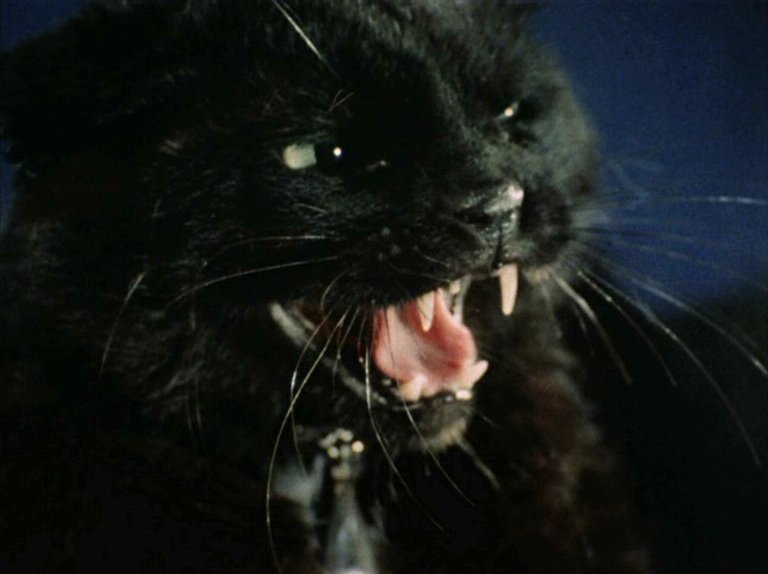Television Review: Catspaw (Star Trek, S2X01, 1967)

Catspaw (S02E01)
Airdate: October 27th 1967
Written by: Robert Bloch
Directed by: Joseph Pevney
Running Time: 50 minutes
The earliest incarnation of Star Trek (The Original Series or TOS) was undeniably shaped by the constraints and conventions of 1960s American broadcast television. Among these was the requirement for occasional holiday-themed episodes, a formulaic staple designed to capitalise on seasonal moods and viewer expectations. While The Original Series adhered to this convention only once, with Season 2’s Catspaw, no subsequent Star Trek iteration followed suit, rendering this episode uniquely anomalous in the franchise’s history. Its Halloween setting, Gothic-inflected narrative, and thematic reliance on illusion and fear set it apart from the show’s more cerebral or politically charged instalments, marking it as an outlier even within its own era.
Catspaw represents the second contribution by Robert Bloch, the celebrated horror writer best known for his 1959 novel Psycho. The episode draws loosely from his 1957 short story Broomstick Ride. Bloch’s influence is palpable in the episode’s eerie atmosphere and its exploration of human vulnerability when confronted with forces beyond comprehension—a tension that defines the Gothic genre.
The plot unfolds as the Enterprise conducts a routine survey of the seemingly uninhabited planet Pyris VIII. When Sulu and Scott fail to return from a landing party, while Crewman Jackson arrives dead with a cryptic warning about a curse, Captain Kirk, Spock, and McCoy beam down to investigate. The trio encounters a spectral gathering of ‘witches’ before stumbling into a Gothic-style castle, a setting that evokes classic horror tropes. Captured by the castle’s inhabitants, they discover Sulu and Scott have been reduced to zombie-like servants of Korob (William Marcuse), an alien capable of altering his appearance and environment through advanced technology masquerading as magic. Korob, accompanied by his enigmatic companion Sylvia (Antoinette Bower), who adopts the form of a seductive human enchantress, seeks to exploit the crew’s humanity. Kirk’s strategy hinges on manipulating Sylvia’s curiosity about human emotions, ultimately enabling the crew to outwit their captors.
The episode’s production history sheds light on its peculiarities. Filmed as the first episode of Season 2 but aired seventh, Catspaw was deliberately saved for a Halloween slot, a decision NBC believed would heighten its seasonal appeal. This scheduling choice explains the abrupt shift in Pavel Chekov’s hair and wig, which differs noticeably from earlier episodes—a continuity error that has long frustrated purist fans. The episode’s Halloween alignment also accounts for its Gothic aesthetic, which clashes slightly with Star Trek’s typically rationalist ethos, creating an uneasy blend of sci-fi and horror.
Technically, Catspaw begins with commendable atmosphere, leveraging its mystery and Gothic tropes to engage viewers. The opening scenes—replete with fog, eerie lighting, and the haunting presence of the ‘witches’—establish a taut, suspenseful tone. However, the narrative stumbles when it resorts to Clarke’s Third Law (“sufficiently advanced technology is indistinguishable from magic”) to explain the aliens’ powers. While this trope is a staple of science fiction, its application here feels perfunctory, stripping the horror elements of their menace. Korob and Sylvia, though visually distinct (their identical true forms revealed late in the episode), are ultimately underwhelming antagonists: their motivations are petty and human-like, undermining the potential for genuine cosmic dread. Their ‘technology as magic’ gimmick, while clever in theory, fails to elevate the story beyond a routine monster-of-the-week plot.
Visually, the episode suffers from dated special effects and awkward direction by Joseph Pevney, a helmsman usually more assured. The castle set is serviceable but generic, while the ‘witches’ are conveyed via unconvincing optical illusions. Pevney’s choices, such as abrupt camera angles and static staging, occasionally disrupt the tension, particularly during the climactic confrontation. These shortcomings, coupled with the script’s reliance on exposition-heavy dialogue, dilute the episode’s early promise.
The performances, however, are generally competent. William Marcuse, who would tragically die in a car accident a month after the episode’s broadcast, imbues Korob with a smug, theatrical menace, though his character lacks depth. Antoinette Bower, as Sylvia, fares better, injecting nuance into her role as a conflicted alien intrigued by human emotion. Her chemistry with Kirk grounds the otherwise fantastical premise, though her character’s arc remains underexplored.
In conclusion, Catspaw is a serviceable but unremarkable entry in Star Trek’s canon. While its Halloween theme offers a fleeting novelty and its Gothic trappings provide atmospheric intrigue, the episode ultimately fails to transcend its formulaic structure or deliver the intellectual or emotional depth that defined TOS at its best. Its reliance on technobabble to resolve the mystery feels like a cop-out, neutering the potential for genuine horror or philosophical inquiry. For fans, it remains an interesting curiosity—a relic of mid-1960s television conventions and a reminder of the series’ occasional forays into genre hybridity. Yet, beyond its status as the franchise’s sole Halloween special, Catspaw leaves little lasting impression, its strengths overshadowed by narrative laziness and technical limitations.
RATING: 5/10 (++)
Blog in Croatian https://draxblog.com
Blog in English https://draxreview.wordpress.com/
InLeo blog https://inleo.io/@drax.leo
InLeo: https://inleo.io/signup?referral=drax.leo
Hiveonboard: https://hiveonboard.com?ref=drax
Rising Star game: https://www.risingstargame.com?referrer=drax
1Inch: https://1inch.exchange/#/r/0x83823d8CCB74F828148258BB4457642124b1328e
BTC donations: 1EWxiMiP6iiG9rger3NuUSd6HByaxQWafG
ETH donations: 0xB305F144323b99e6f8b1d66f5D7DE78B498C32A7
BCH donations: qpvxw0jax79lhmvlgcldkzpqanf03r9cjv8y6gtmk9
I enjoyed your analysis.
Your critique balances appreciation for the Gothic atmosphere with honest assessment of its shortcomings. I particularly agree with your point about how the "technology as magic" explanation undermines the horror elements that could have made this episode more compelling.
Thank you for sharing!